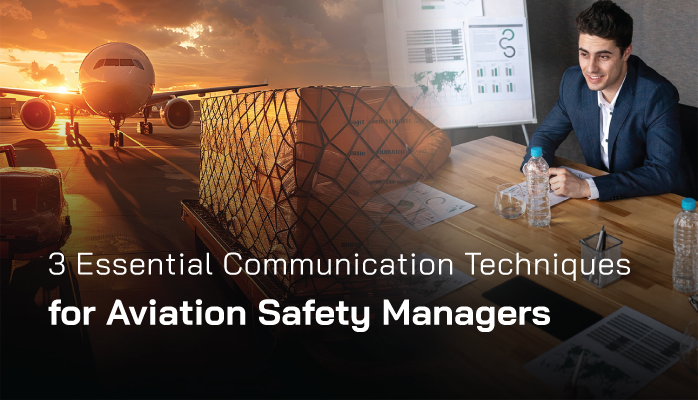Communication Critical to Aviation Safety Managers Role

Aviation safety managers need to give feedback – both praise and criticism – to employees and management regularly. It’s an essential part of their role as a leader in driving the performance of their aviation safety management system (SMS).
Safety managers who communicate well with employees and other managers tend to be significantly more successful in all areas of their aviation SMS, such as:
- Aviation safety implementation;
- Overcoming resistance to change;
- Garnering executive management support (i.e. budget) for the SMS; and
- Promoting a transparent safety reporting culture.
The hard thing about communication is that the concepts are generally simple, but putting them into practice in the real world of relationships and emotions can be extremely difficult. Moreover, it can require a sobering dose of honesty to admit where you don’t communicate well.
Related Communication in Aviation SMS Articles
- How to Be Compliant With Safety Communication in Aviation SMS
- Cultivating Teamwork and Communication in Aviation SMS - With Free Resources
- Let’s Talk Human Factors - Lack of Communication
An Important Tip to Remember
An important thing to remember is that while we think of communication that happens at the moment, there is no reason why safety managers can’t plan out their communication feedback strategies. Planning communication feedback can be as simple as:
- Giving positive feedback in safety newsletters;
- Daily safety email messages;
- Safety meetings where feedback is outlined ahead of time.
The basic fact is that communication doesn’t have to be spontaneous – it can and often should be carefully considered ahead of time. The reason is that at the moment we are standing in front of our audience, most of us simply don’t always say what we mean to, or don’t say it as well as we could have if it had been planned.
1 – Know Your Audience
One of the most important reasons to be friendly and familiar with all employees in your aviation SMS is that, oftentimes, effective communication and feedback hinge on knowing whom you are talking to and what are their preferences. Often, lack of communication in aviation SMS is simply a lack of knowing whom you are communicating with. Some employees would rather receive praise in private. Some employees may require a more sensitive approach to giving criticism; others may prefer a more direct approach.
For aviation safety managers, knowing the individual preferences of employees in their safety program will allow them to engage more effectively with individual employees while actually communicating. Moreover, they will be able to plan what they want to say and consider how they want to say it, ahead of time.
Related Human Factors Articles
- Let’s Talk Human Factors - Origin of Dirty Dozen
- Let’s Talk Human Factors - Lack of Knowledge
- Human Factors: Lack of Teamwork
2 – Be Detail Specific With Praise and Criticism
Feedback, both praise and criticism should be as specific as possible. Being specific with praise and feedback greatly benefits aviation risk management by:
- Clarifying the specific types of safety actions, attitudes, and behaviors that are beneficial/harmful for risk management; and
- Gives employees clear expectations; and
- Reinforces the fact that the aviation safety managers are sincere about safety performance and improvement.
Often, managers fear being too specific because they are worried it gives the impression of “lording over” employees or being hyper-critical. If done in excess, this is certainly true. But when I say that aviation safety managers should be specific in their communication, it is simply the difference between, for example, “You don’t seem very involved in the SMS lately,” and “You haven’t reported any safety concerns in the past 3 months.”
Once again, planning carefully ahead of time before such communications can greatly improve a safety manager’s ability to be specific when communicating concerns or praise.
3 – Don’t Wait to Give Feedback

One of the caveats with effective communication is doing it promptly. Aviation safety managers whom I know are very good at their jobs all take care of things very quickly. Communication included. This is particularly true when giving criticism.
Giving criticism isn’t something most managers look forward to. Criticism has a stunning potential to:
- Alienate employees; and/or
- Be met with anger and defensiveness.
Furthermore, “stockpiling” criticism will only make a safety manager seem petty and will breed mistrust. If safety managers wait until a year-end review to comment on a mistake an employee made at the beginning of the year, then that is almost a whole year of missed opportunity for growth for the aviation SMS. Moreover, because we are talking about the safety program, immediate feedback can be the difference between a safety problem and safety mitigation.
Critical feedback is best given while it is fresh in the employee and manager’s minds. A great technique to overcome the potential for alienation and/or anger is approaching the problem by trying to understand the behavior, as well as coming up with an action plan together.
Related Human Factors Articles
- Let’s Talk Human Factors: Distraction Is #4 of the Dirty Dozen
- Let’s Talk Human Factors - Complacency
- 5 Things to Know About Aviation SMS Human Factors
Final Thought: Assessing Your Communication Performance
Communication in aviation SMS is absolutely essential for
- continuous improvement,
- safety performance, and
- safety culture.
When done well, employees in a safety program benefit with:
- Having clear expectations;
- Having a clear understanding of how they are performing;
- Feeling responsible and justly rewarded for good actions; and
- Having incentives to be assertive without fear of being “laid into.”
But to communicate effectively, safety managers need to know how their communication efforts are going. The best way to find out is to simply ask. This can be done:
- One-on-one with a trusted employee;
- In a safety meeting; or
- Via an anonymous safety survey.
Ultimately communication is not about what you “intend” but about what other people hear. For aviation risk management programs to be successful, safety management needs to know how well they are communicating with employees.
What is your communication style? Does your communication style align with, or affect your safety management style?
What sort of safety manager are you?
Last updated in February 2025.







